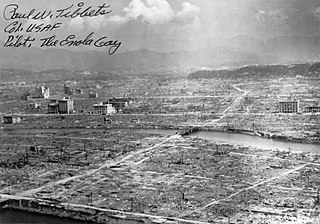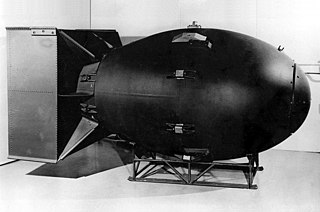Related Research Articles

The Anti-Ballistic Missile Treaty (1972—2002) was an arms control treaty between the United States and the Soviet Union on the limitation of the anti-ballistic missile (ABM) systems used in defending areas against ballistic missile-delivered nuclear weapons. Under the terms of the treaty, each party was limited to two ABM complexes, each of which was to be limited to 100 anti-ballistic missiles.

In nuclear strategy, a first strike is a preemptive surprise attack employing overwhelming force. First strike capability is a country's ability to defeat another nuclear power by destroying its arsenal to the point where the attacking country can survive the weakened retaliation while the opposing side is left unable to continue war. The preferred methodology is to attack the opponent's strategic nuclear weapon facilities, command and control sites, and storage depots first. The strategy is called counterforce.

Mutual assured destruction (MAD) is a doctrine of military strategy and national security policy in which a full-scale use of nuclear weapons by two or more opposing sides would cause the complete annihilation of both the attacker and the defender. It is based on the theory of deterrence, which holds that the threat of using strong weapons against the enemy prevents the enemy's use of those same weapons. The strategy is a form of Nash equilibrium in which, once armed, neither side has any incentive to initiate a conflict or to disarm.

START I was a bilateral treaty between the United States and the Soviet Union on the reduction and the limitation of strategic offensive arms. The treaty was signed on 31 July 1991 and entered into force on 5 December 1994. The treaty barred its signatories from deploying more than 6,000 nuclear warheads and a total of 1,600 intercontinental ballistic missiles (ICBMs) and bombers.

The nuclear arms race was an arms race competition for supremacy in nuclear warfare between the United States, the Soviet Union, and their respective allies during the Cold War. During this same period, in addition to the American and Soviet nuclear stockpiles, other countries developed nuclear weapons, though none engaged in warhead production on nearly the same scale as the two superpowers.

The Russian Federation is known to have possessed three types of weapons of mass destruction: nuclear weapons, biological weapons, and chemical weapons. It is one of the five nuclear-weapon states recognized under the Treaty on the Non-Proliferation of Nuclear Weapons. The nation possesses approximately 6,400 nuclear warheads—the largest stockpile of nuclear weapons in the world. More than half of the world's 14,000 nuclear weapons are owned by Russia. Russia's predecessor state, the Soviet Union, reached a peak stockpile of about 45,000 nuclear warheads in 1986.

The United States is known to have possessed three types of weapons of mass destruction: nuclear weapons, chemical weapons, and biological weapons. The U.S. is the only country to have used nuclear weapons in combat, when it detonated two atomic bombs over the Japanese cities of Hiroshima and Nagasaki during World War II. It had secretly developed the earliest form of the atomic weapon during the 1940s under the title "Manhattan Project". The United States pioneered the development of both the nuclear fission and hydrogen bombs. It was the world's first and only nuclear power for four years (1945–1949), until the Soviet Union managed to produce its own nuclear weapon. The United States has the second-largest number of nuclear weapons in the world, after the Russian Federation.

The United Kingdom possesses, or has possessed, a variety of weapons of mass destruction, including nuclear, biological, and chemical weapons. The United Kingdom is one of the five official nuclear weapon states under the Treaty on the Non-Proliferation of Nuclear Weapons and has an independent nuclear deterrent. The UK has been estimated to have a stockpile of 120 active nuclear warheads and 215 nuclear warheads in total. Since 2010, the size of this stockpile has been capped at a maximum of 180 warheads; however, this cap is set to rise to 260 from 2021 — the first time it has risen since the Cold War. The UK renounced the use of chemical and biological weapons in 1956 and subsequently destroyed its general stocks. The UK plans to increase its nuclear warhead stockpile by 40%, raising the number to a maximum of 260 warheads.

As the collapse of the Soviet Union appeared imminent, the United States and their NATO allies grew concerned of the risk of nuclear weapons held in the Soviet republics falling into enemy hands. The Cooperative Threat Reduction (CTR) Program was an initiative housed within the Defense Threat Reduction Agency (DTRA). The CTR program is better known as the Nunn–Lugar Act which was authored and cosponsored by Sens. Sam Nunn (D-GA) and Richard Lugar (R-IN). This Act was created in 1986 in a congressional meeting. According to the CTR website, "the purpose of the CTR Program is to secure and dismantle weapons of mass destruction and their associated infrastructure in former Soviet Union states." An alternative explanation of the program is "to secure and dismantle weapons of mass destruction in states of the former Soviet Union and beyond".

The R-36 is a family of intercontinental ballistic missiles (ICBMs) and space launch vehicles (Tsyklon) designed by the Soviet Union during the Cold War. The original R-36 was deployed under the GRAU index 8K67 and was given the NATO reporting name SS-9 Scarp. It was able to carry three warheads and was the first Soviet MRV(multiple reentry vehicle) missile. The later version, the R-36M was produced under the GRAU designations 15A14 and 15A18 and was given the NATO reporting name SS-18 Satan. This missile was viewed by certain United States analysts as giving the Soviet Union first strike advantage over the U.S., particularly because of its rapid silo-reload ability, very heavy throw weight and extremely large number of re-entry vehicles. Some versions of the R-36M were deployed with 10 warheads and up to 40 penetration aids and the missile's high throw-weight made it theoretically capable of carrying more warheads or penetration aids. Contemporary U.S. missiles, such as the Minuteman III, carried up to three warheads at most.

A strategic nuclear weapon refers to a nuclear weapon that is designed to be used on targets often in settled territory far from the battlefield as part of a strategic plan, such as military bases, military command centers, arms industries, transportation, economic, and energy infrastructure, and heavily populated areas such as cities and towns, which often contain such targets. It is in contrast to a tactical nuclear weapon, which is designed for use in battle as part of an attack with and often near friendly conventional forces, possibly on contested friendly territory.

The Ministry of Defence of Ukraine was established on 24 September 1991, one month after Ukraine's declaration of independence resolution. The ministry was put in charge of all Soviet military forces reorganization on the territory of Ukrainian jurisdiction.

The Alma-Ata Protocols were the founding declarations and principles of the Commonwealth of Independent States (CIS). The leaders of Russia, Ukraine, and Belarus had agreed to the Belovezha Accords on 8 December 1991, dissolving the Soviet Union and forming the CIS. On 21 December 1991, Armenia, Azerbaijan, Belarus, Kazakhstan, Kyrgyzstan, Moldova, Russia, Tajikistan, Turkmenistan, Ukraine, and Uzbekistan agreed to the Alma-Ata Protocols, joining the CIS. The latter agreement included the original three Belavezha signatories, as well as eight additional former Soviet republics. Georgia was the only former republic that did not participate while Lithuania, Latvia and Estonia refused to do so as according to their governments, the Baltic states were illegally incorporated into the USSR in 1940.

Prior to 1991, Ukraine was part of the Soviet Union and had Soviet nuclear weapons in its territory.

The Moscow Summit was a summit meeting between U.S. President Ronald Reagan and General Secretary of the Communist Party of the Soviet Union Mikhail Gorbachev. It was held on May 29, 1988 – June 3, 1988. Reagan and Gorbachev finalized the Intermediate-Range Nuclear Forces Treaty (INF) after the U.S. Senate's ratification of the treaty in May 1988. Reagan and Gorbachev continued to discuss bilateral issues like Central America, Southern Africa, the Middle East and the pending withdrawal of Soviet troops from Afghanistan. Reagan and Gorbachev continued their discussions on human rights. The parties signed seven agreements on lesser issues such as student exchanges and fishing rights. A significant result was the updating of Soviet history books, which necessitated cancelling some history classes in Soviet secondary schools. In the end, Reagan expressed satisfaction with the summit.
The Lisbon Protocol to the 1991 Strategic Arms Reduction Treaty was a document signed by representatives of Russia, Belarus, Ukraine, and Kazakhstan that recognized the four states as successors of the Union of Soviet Socialist Republics and all of them assume obligations of the Soviet Union under the START I treaty. The protocol was signed in Lisbon, Portugal, on 23 May 1992.

Otradnoye or Vidradne is an urban-type settlement in the Yalta municipality of the Autonomous Republic of Crimea, a territory recognized by a majority of countries as part of Ukraine and annexed by Russia as the Republic of Crimea.

Sovietske is an urban-type settlement in the Yalta Municipality of the Autonomous Republic of Crimea, a territory recognized by a majority of countries as part of Ukraine and annexed by Russia as the Republic of Crimea.
The Agreement on settlement of political crisis in Ukraine are the documents, signed on 21 February 2014 by the President of Ukraine Viktor Yanukovych and the leaders of the parliamentary opposition under the mediation of the European Union and Russia. The signing of the Agreement was intended to stop the mass bloodshed in Kyiv and to end the sharp political crisis, which began in November 2013 in connection with the decision of Ukrainian authorities to suspend the process of signing the Association agreement with the European Union.
References
- ↑ (in Russian) Protocol on settlement of issues of Black Sea Fleet (official document). Verkhovna Rada website.
- ↑ (in Russian) Basic principles of utilization of nuclear weapon of Strategic Nuclear Forces located in Ukraine (official document). Verkhovna Rada website.
- ↑ (in Russian) Agreement between the government of Russian Federation and the government of Ukraine on utilization of nuclear warheads (official document). Verkhovna Rada website.
- ↑ Agreement between Ukraine and the Russian Federation on implementation of assured and authoritative supervision for operation of strategic missile systems of Strategic Forces located on their territories (official document). Verkhovna Rada website.